by Megan | Jan 20, 2024 | AAC, blog, tips, training
I want to share my favorite AAC tip with you…
This tip is specifically for those who use an iPad as their communication device. If you have worked with anyone, specifically children, who use an iPad, you know that the “home” button can be very distracting, especially since pressing it will take you out of your communication app. If only there were a way to keep that from happening…enter “Guided Access”!
Guided access is a built-in setting within the accessibility features of all iPads. Once it is set up and enabled, the home button is essentially disabled, and if a user presses the home button, they will be prompted to enter a passcode to disable guided access. Before I continue rambling on about the greatness of guided access, let me show you how to set it up.
Open “settings” on the iPad.
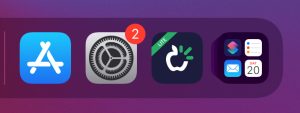
On the left, scroll down to “accessibility” and select it.

On the right, scroll down to “guided access” and select it.

Once “guided access” is selected you can select “passcode settings” to set a passcode that will need to be entered to disable “guided access”. (You will be asked to re-enter the passcode to confirm.)
Once your passcode is set up, navigate to the communication app and open it.

With the communication app open, click the home button three times (triple click) to activate “guided access”.
When guided access is enabled and the home button is pressed, a written prompt will appear at the top of the screen to triple-click the home button to disable it.

If you triple-click the home button, a pop-up will appear, prompting you to enter the passcode you set during setup.
If you enter the correct passcode, you will be prompted to choose “end” or “resume” guided access.

If an incorrect passcode is entered, you will have to wait a designated amount of time before an additional attempt.
Bonus tip!
If the iPad “dies” or runs out of charge, guided access is automatically disabled. Therefore, it never hurts to periodically check to see if guided access is enabled. To do so, just triple-click the home button. If guided access is enabled, the passcode pop-up will appear. If guided access is not enabled, triple-clicking the home button will reactivate it.
by Megan | Jan 13, 2024 | AAC, emergent literacy
How do I get staff to buy into modeling AAC and implementing emergent literacy strategies in their classrooms?
This is one of the questions that I am most frequently asked when talking to other speech-language pathologists (SLPs). While I agree that getting staff buy-in to model AAC and emergent literacy can sometimes feel like a challenge – but, it doesn’t have to! Here’s what I have proposed, introduced, and tried in classrooms I support to help motivate and encourage classroom teachers and staff to continue modeling AAC and implement emergent literacy strategies throughout their day:
- Make sure they understand the terminology.
Special education has 1 BILLION (if not more) acronyms and we often use them so regularly that we forget that everyone may need to learn what they all mean. When talking about different techniques and strategies, take the time to make sure that those you are talking to are clear on what you are saying. It does no good if one or more people leave a discussion about strategies to increase communication and literacy (or anything for that matter) wondering what it was that was discussed and what they can, or should do going forward. If you find yourself using acronyms often, it may be helpful to have a “cheat sheet” or “key” to share that reminds everyone what each acronym stands for.
- Reinforce what they are already doing.
No one likes to only hear what they aren’t doing and what they should do. And, I’m sure there are things that the classroom staff are already doing that are great! It is important to emphasize those things that are going well and that are successful – encouraging others and recognizing what they are doing well goes a long way in building rapport in any relationship!
- Show how they could easily add modeling AAC or emergent literacy into their established routines.
Sometimes, when we hear someone suggest that we “add” something to our day, we immediately stop listening and get defensive. All of us are already doing so much, especially in education, that the idea of adding one more thing is crazy. While this is true, and the last thing we want to do is add more to anyone’s plate – this is a great way to remind those we are supporting that language and literacy are not times of the day – they are always happening and are always around us. Taking the time to show staff simple ways that they can model AAC or implement an emergent literacy strategy into their daily routines can go a long way! Adding in these language and literacy moments doesn’t need to be anything long or time-consuming – it can be a quick mention of the letter of the day while reading instructions, a book, or on a walk about campus, or taking the time to point to a core word or two that naturally comes up during instruction, lunch, etc.
- Ask questions and listen to answers.
This might be the most important tip of all! In all collaborative relationships, it is imperative that everyone involved feels comfortable asking questions and knows that their thoughts, ideas, concerns, etc will be listened to. Take the time to ask questions so you can know how to best support each team, team member, classroom, etc. Ask what their concerns are, how they best learn, what they need more help with, how they like to receive feedback, what area(s) they would like to focus on, etc.
Taking the time to ask these questions and listen to the answers that are given will not only help to build the relationship, it will help guide how you can provide support and feedback as well as know how to help every team member set personal goals surrounding AAC modeling and/or emergent literacy implementation.
- Work together to brainstorm and establish personal goals focusing on these areas.
Once you have established that you are all on the same page, what’s going well, and where more support is needed, it’s time to set some goals. Depending upon how you support classrooms, you may set individual goals with each staff member or you may set goals with the team as a whole, or both. The great thing is that these goals can be personalized to fit everyone’s needs and adjusted as needed. When you are setting these goals, think of it just as you would writing goals for your students, making sure they are meaningful, measurable, and achievable. It’s up to you but I also like to discuss a reward that will be received when a goal is met – to me, this makes it extra motivating and meaningful. A reward could be something physical like a snack food, social such as a shout-out in the staff newsletter, or functional in the form of a set of printed and prepped visuals. Whatever they are, rewards should be as personal as the goals and chosen by the person receiving the reward.
While these are my top 5 tips for helping get classroom buy-in and what has helped me, it is a continual learning process, and keep in mind that some things may need to be added, deleted, tweaked, etc depending upon the teams you are supporting. If you are interested in learning more about this topic and getting access to interest surveys you can give to staff, data sheets, resource links, etc – check out my e-book “AAC & Emergent Literacy Challenge”. This ebook is filled with information on how to get started, strategies to make the challenge successful and fun, questionnaires to gather information and guide challenge creation and implementation, data collection sheets, and more!
If you have additional tips or strategies for classroom buy-in and support – drop them in the comments!

by Megan | Mar 7, 2021 | blog, book recommendations, book tracker, books

I’ve always been an avid reader and love becoming lost in the pages of a book. In 2020, I decided that it would be fun to keep track of the books that I read, and as it always seems to happen, the minute I decided to do that, I happened upon something that would help me So, armed with a love of reading and a fun way to track it, I got to it! Here are the books I read in 2020, a short little blurb about each one and a link if you want to pick up the book for yourself :
Book #1: Grace Not Perfection by Emily Ley
 I still stand by my thoughts of not making resolutions but – I love this tracker and am going to use it to motivate me to be more intentional in making time for reading in 2020!
I still stand by my thoughts of not making resolutions but – I love this tracker and am going to use it to motivate me to be more intentional in making time for reading in 2020!
Book #2: Fall Down 7 Times Get up 8 by Naoki Higashida
 Real talk: I had high hopes and was really excited to read this book, however, after starting to read it I was informed that the author (a young man with ASD) is suspected to have used Facilitated Communication (FC) or the Rapid Prompting Method (RPM) to write the book.
Real talk: I had high hopes and was really excited to read this book, however, after starting to read it I was informed that the author (a young man with ASD) is suspected to have used Facilitated Communication (FC) or the Rapid Prompting Method (RPM) to write the book.
Since there is no evidence and/or research to back up the use of FC and RPM, I was obviously disappointed in learning this information. I lost my faith in that the content of the book was directly from the author, however the information shared within the book is good information for all of us working with individuals with ASD.
Regardless of who wrote the book and whose ideas are shared, the main idea, treating everyone with respect, grace and acceptance no matter our differences, is something that we should ALL keep in the forefront of our minds!
Book #3: Everything is Figureo utable by Marie Forleo
utable by Marie Forleo
This book is chock full of such great information, I’m already planning to re-read it to make sure I can absorb it all!
If you are a dreamer, an over-thinker, a procrastinator, a go-getter, etc this book is a must read – basically, it’s for everyone!
Marie shares too many amazing quotes for self-talk and mantras for me to list, but the one that encompasses them all, and the one that I am continually telling myself is “Everything is Figureoutable” – really everything!
Book #4: Atomic Habits by James Clear
 I highly recommend this book to anyone that wants to make changes in their lives for the better – changes that will turn into habits that will stay with you for life and help make you a better version of you.
I highly recommend this book to anyone that wants to make changes in their lives for the better – changes that will turn into habits that will stay with you for life and help make you a better version of you.
The tips provided within the book are easy to implement gradually and functionally incorporate into your life as you work to create new habits. My favorite parts of the book are the emphasis that is placed upon the ability to use these strategies in all aspects of your life as well as the importance of self-reflection and re-evaluation as you progress to continue your self-improvement.
Book #5: Becoming by Michelle Obama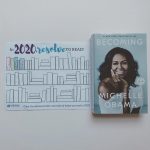
I don’t read a lot of biographies but, I really enjoyed this one! Loved learning about her past, who she was before she was the First Lady of the United States, how she approached her ever changing roles as a woman, mom, advocate and so much more, as well as what she is looking forward to in her new stage in life, outside of politics.
I’m not one that pays much attention to politics at all and this book was less about politics and more about how Michelle Obama changed and evolved throughout her life. Demonstrating to the readers that change is ok and often needed to become the person that you are meant to be and that can make the most difference in this world.
While reading, and after as well, this book has me thinking and reflecting about who I was, who I am, and who I want to become. 
Book #6: Present Over Perfect by Shauna Niequist
When I saw the title of this book I knew I needed to read it! Thanks to Spring Break and the incredible content within, I was able to read this book in one day!
My word for 2020 is “intention” and I am actively trying to increase the intentionality in all actions and aspects of my life. This book gave me so much to reflect upon and help me grow in the areas that I often struggle with – overthinking, worrying and perfectionism. Filling my head and heart with positivity, love for others and self-love is something that I can never have too much of!
Book #7: The Fault In Our Stars by John Green
Sometimes you just need to read a fiction book from 8 years ago.
I have been on a roll with reading books for professional and self growth but felt the need to change it up a little. This book was a good reminder to live your life to the fullest everyday.
Book #8: Practically 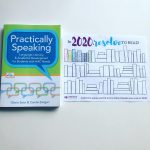 Speaking by Gloria Soto & Carole Zangari
Speaking by Gloria Soto & Carole Zangari
Started reading this book in January with the peeps in the AAC and ASD SLP Book club – here on Facebook.
Finished it up today and will be posting key points from it in the group throughout this week. We will also start voting on what book we should read next.
Want to see what we’ve been shafting about throughout this book and help choose what we read next? Hop over to the group through this link: https://www.facebook.com/groups/443174499698800/?ref=share
See you there!
Book #10 & #11 in 2020: Books 1 & 2 of The Last 13 Series by James Phelan
 Picked up a new series of books to keep my boys occupied with something other than screens and thought I’d read along with them.
Picked up a new series of books to keep my boys occupied with something other than screens and thought I’d read along with them.
There are 13 books in the series and they count down from 13 to 1. Two books in and I’m hooked – they are really good!
Books 12-22 in 2020: Books 3-13 in The Last 13 Series by James Phelan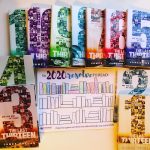
These books are the reason I’ve not been posting as regularly the last week or so. I’ve been obsessed with finishing this series.
I bought the series for my boys and decided to read along with them. Haven’t been this into a young adult series since Harry Potter and Hunger Games!
Book #23 in 2020: Let Me Hear Your Voice by Catherine Maurice

This is an older book – published in 1993 – but the title drew me in when I saw it at my favorite local used bookstore.
A lot of new developments have happened in the world of autism since this book was published, however I LOVE the common themes that were reiterated throughout the book.
All kids with autism are individuals and therefore therapy, life, interactions, etc should be adjusted to best meet their individual needs. The author and mom of the kids in the book, was very adamant that all kids need a variety of therapy – and I loved that they showcased how SLPs and ABA therapists can work together toward a common goal – helping the kiddo be the best they can be!
Another recurring theme that I was so happy was included was that parents know their kiddo(s) best and they should believe in themselves and surround themselves with people that empower them and build them and their families up!
I hope that I am one of those empowering voices for the families that I work with!
Book #24 in 2 020: Fierce, Free and Full of Fire by Jen Hatmaker
020: Fierce, Free and Full of Fire by Jen Hatmaker
At the beginning of 2020 I chose a word for my year – Intention.
My thought process was that I needed (and wanted) to increase my focus and attention to the important things in my life. I was thinking about things outside of myself – my family, my work, my business, etc. – not really thinking about me – on the inside.
Then March came and I started to do a lot more self reflection and thinking about how I could be more intentional with myself. I was thinking about applying my word for 2020 differently.
Although authors like Jen Hatmaker may have been concerned with releasing a book during this time – I can tell you that this was the PERFECT time for me to read this book!
As a person who has (and still continues to) difficulty with accepting myself as I am and letting the world see the true me – this book set me free! I feel empowered & strong enough to let the world see me as I am and to be truthfully, honestly and wholly me!
If you are looking for a book to inspire & encourage you to be you – this is it! We are all meant to be just who we are. Each of us are Fierce, Free & Full of Fire in our own individual ways and when we realize the importance of that, nothing can stop us!
Book #25 in 2020: Get Out Of Your Head by Jennie Allen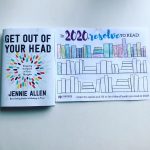
Do you ever gets lost in your head? Thinking about everything and anything until you can’t figure out what is what?
I’ve definitely been there more often than not and so the title of this book definitely caught my attention. Throughout the book Jennie Allen guides readers through different ways to break out of this pattern and to start to change your mindset.
I had to read in bursts, taking time to process and reflect all the thoughts & ideas shared – thinking about how I can apply them to my life.
Two of my favorite takeaways are:
- We can observe our suffering (or thinking) without being overtaken by it.
- We don’t have to like our circumstances, but we can choose to look for the unexpected gifts they may bring.
Looking for a book to challenge your thoughts on mindset and how you are in charge and can take all your thoughts captive – I highly encourage you to pick this one up!
Book #26 of 2020: I Thought It Was Just Me by Brene Brown
This title sucked me in and when I saw it was by Brené Brown I knew it was a must read.
Another read that encourages us to live authentically as we are, vulnerability and all. If you’ve ever thought you were the “only one”’or that “it’s just me” I highly recommend this book. You are not alone, you are enough and wonderful just the way you are!
This final sentence sums it all up – “Change doesn’t require heroics. Change begins when we practice ordinary courage.”
Book #27 in 202 0: Me and White Supremacy by Layla F. Saad
0: Me and White Supremacy by Layla F. Saad
This book challenged me in all the right ways. I will openly say that I typically avoid confrontation at all costs. Anything that makes me uncomfortable, stressed, seems like it might cause tension of any kind, I typically stay away from and don’t try to engage.
No longer – I will not be silent, I am actively anti-racist and I will stand with BIPOC.
We all should, can and need to do better. This is only the beginning for me – I will no longer avoid the hard conversations, the things that need to be said. I will speak up and out to denounce what I know is wrong and pronounce what is right!
Here, listening, learning and doing the internal work to continue on this anti-racist journey.
Books #28-30 in 2020: Polly and Buster Series by Sally Rippin
As a Harry Potter book lover the fact that the main character of these books is a witch caught my attention. However, as I began reading I realized that there was so much more within these books!
Buster and Polly have a unique friendship and connection. They are so close, in fact, that Buster’s appearance (color, size, etc) changes as his emotions change. Talk about a way to open up a discussion about feelings with young readers!
Although this series is geared towards readers ages 7-10, the topics covered throughout the trilogy are important for readers of all ages to learn and remember.
Throughout the series, readers learn and see in action:
- a main character with dyslexia
- increased social emotional awareness for self and others
- true friendship
- importance of standing up for yourself and friends
- believing in yourself
- fighting for what you believe in
- seeing the good in others and yourself
- that everyone is different and that’s fantastic
- everyone should be treated equally
- believing that you can do hard things
- what division over differences looks like and how to bring unity
- promoting justice, quality and understanding
Book #31 in 2020: Artemis Fowl by Eoin Colfer
Disney Plus made me do it! When I saw that they were making a movie off of the books, I knew I wanted to read the book first. To be honest, I wasn’t a raving fan but will read the remaining books in the series to see how the story line evolves and changes. Who knows? Maybe I’ll be a big fan by the end of the series?
Now I just have to decide if I watch the movie now or wait until I have read the other novels in the series…
Book #32 in 2020: Comprehensive L iteracy for All by Karen Erickson and David Koppenhaver
iteracy for All by Karen Erickson and David Koppenhaver
When this book was released I knew I HAD to have it and read it! I ordered it immediately and it did not disappoint!!
If you are passionate about literacy for ALL, work with individuals with complex communication needs, and/or want to develop your ability to effectively teach literacy – you MUST pick up a copy of this book!
I savored every word, highlighted paragraphs and pages at a time, and know that it is a book that will easily become dog-eared and warn as I continue to re-read it over and over again!
Book #33 in 2020: Own Your Everyday by Jordan Lee Dooley

If I hadn’t already heard great things about this book I know that the title itself would have attracted me to it.
Who doesn’t want to live into their PURPOSE and few free enough to do so? I know I do and this book definitely help ensure that I am in the right mindset to do just that.
Best thing of all, Jordan writes like she’s your BFF and you are sitting on a couch in comfy clothes, no makeup, drinking coffee, wine, cider, tea, etc. Reading her tips and advice felt like a conversation and motivational chat which made it easy to read and know that I can apply to my everyday life.
Book #34 in 2020: How To Be An Antiracist by Imbram X. Kendi
A MUST read! So much to think about, reflect on and act on.
What I learned from this book will stick with me forever.
Book #35 in 2020: I’m Still Here: Black Dignity in a World Made for Whiteness by Autsin Channing Brown
Add this book to your list ASAP! So captivating, haunting and beautifully written, I couldn’t put it down & read it in one day.
The stories shared within broke my heart, opened my mind and are stories I will not forget.
Book #36 in 2020: A Tree Grows in Brooklyn by Betty Smith
It took me a little longer to read this one because of its length but it’s definitely worth the time to read it.
A story full of resilience, persistence and overcoming obstacles, as well as the importance of keeping a positive mindset no matter what life throws at you. It’s clear why it’s a classic and still rings true 77 years after its original publication!
Book #37 of 2020: The Ballad of Songbirds and Snakes by Suzanne Collins
I’m always a little leery of “prequel” books that are released after the “original” series. I’m not sure why, but I think that it’s because, especially if I loved the series, I’m afraid the “prequel” won’t hold up.
Thankfully, soon after I started reading – this prequel to the Hunger Games series did not disappoint! I was hooked from the beginning – learning about the past of Coriolanus Snow and how he became the ruler that he was in the Hunger Games series.
Although it was lengthy, I was engaged throughout and the twists and turns of the storyline kept me guessing and surprised until the very end!
Book #38 in 2020: The Culture Code by Clotaire Rapaille
My husband says I’m a marketer’s dream – so the subtitle of this book caught my eye! “An Ingenious Way To Understand Why People Around The Works Live And Buy As They Do”
Plus, I’ve always been interested in learning more about people, why we do what we do, how that varies from country to country and within cultures. This book opened my eyes – the observations and thoughts make total sense and definitely have me thinking!
It was written 14 years ago but the messaging still rings true today!
 Book #39 in 2020: Internment by Samira Ahmed
Book #39 in 2020: Internment by Samira Ahmed
My high school freshmen (twin boys) read this in their history class this year. They loved it and urged me to read it – both as they were reading it as well as when they were finished reading.
I was hooked from the moment I started reading. It’s a fiction book but – unfortunately, with how crazy the world has been lately, it could be non-fiction.
A riveting novel sharing the fight and determination of a young girl fighting against religious persecution and the nation joining together with her. Easily one of my top reads for 2020!
Books #40-42 in 2020: The Time Warp Trio series by Jon Scieszka
You know I can’t resis t looking through bookshelves no matter where I see them right?
t looking through bookshelves no matter where I see them right?
That’s how I found these books. While we were setting up for the winter book walk, I started browsing through the bookshelves in the teacher work room and found these books.
The titles drew me in as I’m also a fan of funny and punny titles for books. The books themselves are a fun way for young readers to learn a little about history while keeping them engaged and learning to love reading.
Whew – that was a lot of reading and I’m keeping it up in 2021 with the help of a new book tracker!
Want to join me in keeping track of the books you read in 2021? You can download my reading tracker here: 2021 Book Tracker
Happy Reading!
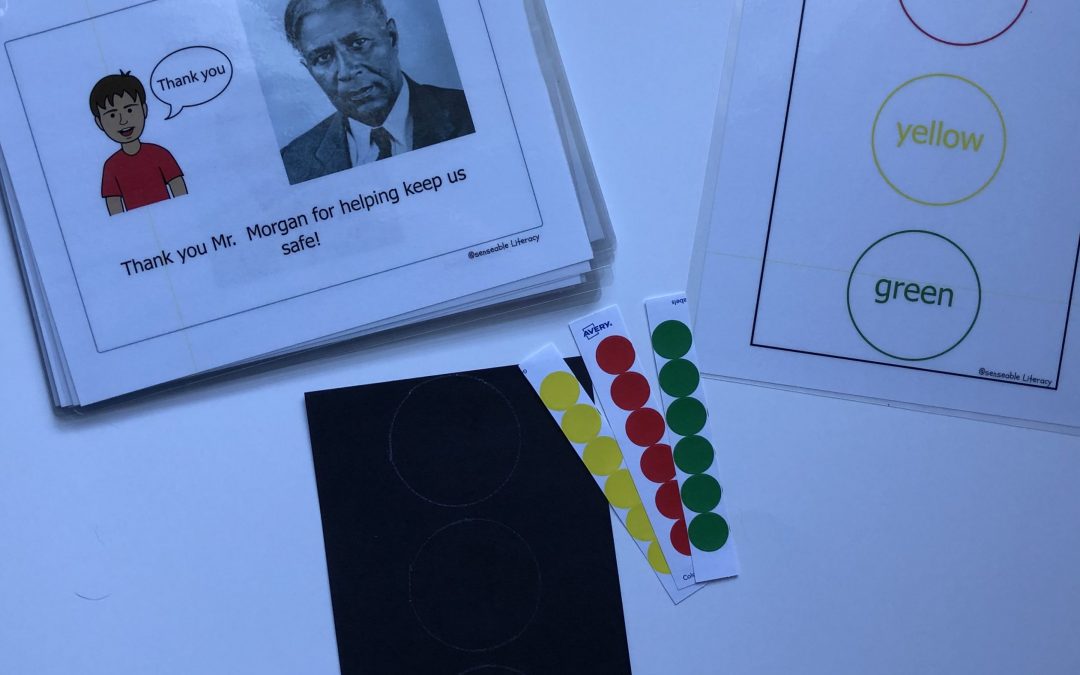
by Megan | Feb 10, 2021 | AAC, aided language stimulation, core vocabulary, modeling, Sensory, Sensory extension activities, Storybook Sessions
Storybook Sessions: Garrett Morgan
In each Storybook Sessions post, I highlight a book that I have used, or plan to use in therapy as well as associated, extension activities that can be paired with the book to increase vocabulary comprehension, provide opportunities to express yourself verbally, written, creatively, etc., sensory exploration, fine motor practice, gross motor movements, etc. Some extension activities will focus on all of these components while others will focus more specifically on one area.
Garrett Morgan
Author: Megan Stewart
Illustrator: Symbols by Boardmaker 7
Do you ever have an idea for an activity to do, book to read, etc but can’t find exactly what you are looking for? Anyone else, or is it just me?
This happened to me while I was planning for my February sessions. I knew I wanted to highlight a famous black person from history to celebrate Black History Month with my students but while looking for a book to lead my activity/session, I wasn’t able to find what I was looking for. I will say that there are a TON of great kids books featuring and highlighting famous black people, however I waited too long to put these on hold or check out from my library, so I decided to create my own.
My Book Creation Process
I chose to highlight Garrett Morgan, who added the yellow light to the stoplight as we now know it, within my lesson. With a quick Google search to find a picture of him, and learn a little more about him and his inventions, I took that information, opened Boardmaker 7 software and got to work! Using the printable book template, I was able to easily add in pictures, symbols and text that told the story of who Garrett Morgan was, why we need to learn about him, what his invention was (Mr. Morgan did invent items other than the stoplight, (i.e., the gas mask), but I thought this invention was most appropriate to highlight for my PreK students), and how it has affected our world. Here’s a sneak peek of the book:
Now What?
Now that I had the book, I needed to decide on the extension activities to continue our learning after we read the book. I chose activities that focused on color, shape and number recognition & labeling, spatial concepts, fine motor skills, bi-lateral (both sides) hand coordination, sorting, following directions, and gross motor skills.
Creating A Personalized Stoplight
In the first activity, the students create their own stoplight.
First, I cut black construction paper into rectangles and drew 3 circles down the center with a white crayon.

Stoplight template and stickers
Second, I cut color coding stickers from Avery into strips of yellow, green and red.
Each student was given a stoplight template and, after a model from an adult, placed all of the colored stickers onto their stoplight template. Hopefully the students placed the stickers in the right place based on color, but if not, that’s ok too – I am all about fostering independence and creativity and this is not a test!
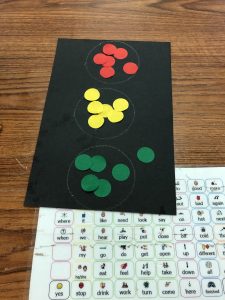
Student Created Stoplght

Student Created Stoplight
Additional Skills Addressed While Creating the Stoplights
While the students were making their stoplights, we were able to focus in on the topics of:
- Colors
- Shapes
- Location words (prepositions)
- Quantity (numbers, more, less)
Don’t forget all the Core Vocabulary!
And of course we used our core vocabulary communication boards to chat, modeling words, individually and in short phrases, such as:
- Put
- On
- More
- Where
- Help
- Want
- Like
- Not
- Different
- I
- My
- You
- Finished
- Here
- That
- Again
- Next
- See
- All
The Fun Doesn’t Stop There!
After students finish their stoplight you can:
- Help them write their name on their paper and send home to share with families.
- Laminate their stoplight to use in additional extension activities such as sorting by color.
- Use this sorting template to find items that are red, yellow and/or green in their environment.
- Watch some fun “stoplight videos” such as:
- Play “Red Light, Yellow Light, Green Light” to help get the wiggles out. You can use these visuals to further show students if they are to “GO”, “SLOW” or “STOP”.
- Play with cars and other vehicles, using your traffic light to tell the cars to “GO”, “SLOW down” or “STOP”
This Sounds Great! Where Can I Find These Resources?
If you are interested in doing these activities and/or reading the book about Garrett Morgan to your students I have linked them here for you to download:

Garrett Morgan book and activities

Garrett Morgan Printable and activities
If you create stoplights in celebration of Garrett Morgan and his invention, I’d love to see it!
Post pictures in the comments below or tag me (@senseableliteracy) in posts online!
Until next time – Happy Reading!
















































Recent Comments